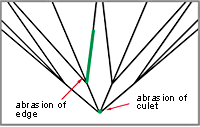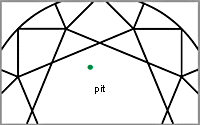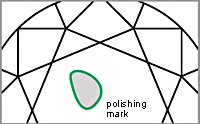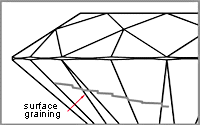 |
Edge and culet abrasion
Abrasion appears as blunting or smoothing of some spots or points of a stone (microdents).
Abbreviation:
Abr.
Observation method:
Abrasion of the culet is observed from the side of the culet or through the table. In some cases, 20-30 X magnification (microscope) is used. Ultimate grading is performed with a 10 X loupe. Abrasion can be mistaken for a very small or an unproperly pointed culet
It often appears as a light smoothed point. Abrasion of edges is detected by successive examination of the crown and then pavilion facets. |
|
 |
Rough (or bearded) girdle
Abbreviation:
RG, BG
Observation method:
The roughness is detected in profile examination, while the bearding is observed through the table or from the side of the culet. This defect is formed as a result of stone bruting.
The surface of the rough girdle is covered by fine light sugar-like protuberance. The beard is formed by
- ýòî microcracks. If the cracks extend into the stone, the beard is classified as cracking and is considered in clarity grading. |
|
 |
Chips and nicks.
Abbreviation:
NK.
Observation method:
chips and nicks basically occur in the girdle zone, on edges, and near the culet. Chip is gentler, while nick is deeper. If these defects cannot be removed by repolishing, they should be taken into account in clarity grading. |
|
 |
Polish lines and scratches
Abbreviation:
PL,S
Observation method:
polish lines mainly occur around the culet, but may also be present on any facets. To detect the polish lines and scratches, facets are tilted in various planes to catch reflection on them. |
|
 |
Pits
Abbreviation:
Pit
Pit is a pointed track on a stone facet produced by a blow. A pit usually appears as a light dot. To distinguish a pit from a dust, one is recommended to catch reflection on the facet or to clean it one more time. |
|
 |
Polishing marks
Abbreviation:
PM
Surface turbidity can be caused by excess heating of diamond surface during polishing or by dirt. As a result, the facet has a poor luster and may be covered with white, gray, brown, or dark tarnish. Additional washing of the stone in acid is recommended.
|
|
 |
Exposure of structural defects to the surface (surface graining).
Abbreviation: STR
It often appears as a broken line. To refer a structural inhomogeneity
to as a polish defect only, a grader must be sure that visible signs of internal structural defects are absent
|






